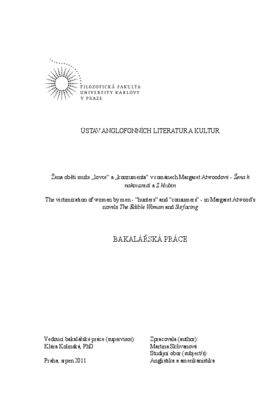The victimization of women by men - "hunters" and "consumers" - in Margaret Atwood's novels The Edible Woman and Surfacing
Žena obětí muže "lovce" a "konzumenta" v románech Margaret Atwoodové - Žena k nakousnutí a Z hlubin
bachelor thesis (DEFENDED)

View/
Permanent link
http://hdl.handle.net/20.500.11956/50394Identifiers
Study Information System: 96432
CU Caralogue: 990013856850106986
Collections
- Kvalifikační práce [24014]
Author
Advisor
Referee
Jindra, Miroslav
Faculty / Institute
Faculty of Arts
Discipline
English and American Studies
Department
Department of Anglophone Literatures and Cultures
Date of defense
12. 9. 2011
Publisher
Univerzita Karlova, Filozofická fakultaLanguage
English
Grade
Excellent
Keywords (Czech)
Žena k nakousnutí, Z hlubin, Margaret Atwoodová, Susan Sontagová, Roland Barthes, Carol J. Adamsová, viktimizace, objektifikace, ženy, oběti, lovení, fotografieKeywords (English)
The Edible Woman, Surfacing, Margaret Atwood, Susan Sontag, Roland Barthes, Carol J. Adams, victimization, objectification, women, victims, hunting, photographyBakalářská práce se zabývá ranou tvorbou kanadské spisovatelky Margaret Atwoodové - romány Žena k nakousnutí (1969) a Z hlubin (1972). Práce se zaměřuje na viktimizaci a objektifikaci ženských postav skrze fotografování a konzumaci. Tato dvě témata jsou stěžejní pro dvě kapitoly statě bakalářské práce. První kapitola se zabývá teorií fotografie Susan Sontagové a Rolanda Bartha a aplikuje ji na oba romány. Pomocí fotoaparátu či kamery získává muž nad ženou nadvládu. Podobně jako střelná zbraň je fotoaparát jednoduše ovládán pomocí spouště, která přemění osobu svého zájmu na trofej - předmět v neměnné pozici, se kterým lze lehce manipulovat. Práce se proto také zabývá podobnostmi mezi ženskými a zvířecími obětmi a lovením. Roland Barthes se ve Světlé komoře (1980) věnuje pozóváním před fotografem. Je přesvědčen, že v momentu fotografování ze sebe osoba čekající na stisknutí spouště sama vytvoří objekt a ztrácí tak své vlastní já - s touto verzí vyobrazené osoby může fotograf potom naložit podle sebe. Pohled fotoaparátu a kamery je bezohledný a kořistnický, což je v práci rozvedeno pomocí feministické teorie Laury Mulveyové, která ve své antologii Vizuální a jiné slasti (1989) tvrdí, že fotoaparát je nástavbou mužského objektifikujícího pohledu. Druhá kapitola se zabývá konzumací. Hlavním argumentem...
The thesis deals with the early works of the Canadian writer Margaret Atwood - novels The Edible Woman (1969) and Surfacing (1972). The thesis focuses on victimization and objectification of the female characters through photography and consumption. The two topics are crucial for the two "body" chapters of the thesis. The first chapter deals with Susan Sontag's and Roland Barthes' theory of photography, and applies it to both novels. With the help of a camera, the man takes control over the woman. Similarly to a gun, it is a device with a release one can easily press to overpower its subject and turn it into a trophy - an object in its unalterable position one can manipulate with easily. Therefore, the thesis also explores the parallels between female and animal victims and hunting. Roland Barthes in his Camera Lucida (1980) analyses posing in front of the photographer. He is convinced that at the moment of picture taking the person waiting for the pull of the trigger transforms themselves into an object and thus loses their real self - with this version of the portrayed person, the photographer can manipulate according to his will. The gaze of the camera is unscrupulous and predatory; the thesis elaborates on it by the feminist theory of Laura Mulvey, who in her anthology Visual and Other...
